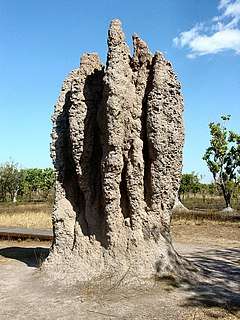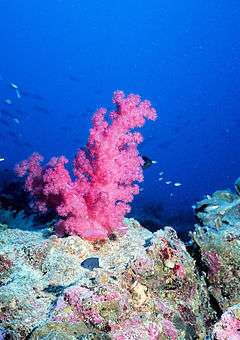Superorganism


A superorganism or supraorganism (the latter is less frequently used but more etymologically correct)[1] or extended organism[2] is a group of synergistically interacting organisms of the same species. A community of synergistically interacting organisms of different species is called a holobiont.
Concept
The term superorganism is used most often to describe a social unit of eusocial animals, where division of labour is highly specialised and where individuals are not able to survive by themselves for extended periods. Ants are the best-known example of such a superorganism. A superorganism can be defined as "a collection of agents which can act in concert to produce phenomena governed by the collective",[3] phenomena being any activity "the hive wants" such as ants collecting food and avoiding predators,[4][5] or bees choosing a new nest site.[6] Superorganisms tend to exhibit homeostasis, power law scaling, persistent disequilibrium and emergent behaviours.[7]
The term was coined in 1789 by James Hutton, the "father of geology", to refer to Earth in the context of geophysiology. The Gaia hypothesis of James Lovelock,[8] and Lynn Margulis as well as the work of Hutton, Vladimir Vernadsky and Guy Murchie, have suggested that the biosphere itself can be considered a superorganism, although this has been disputed.[9] This view relates to systems theory and the dynamics of a complex system.
The concept of a superorganism raises the question of what is to be considered an individual. Toby Tyrrell's critique of the Gaia hypothesis argues that Earth's climate system does not resemble an animal's physiological system. Planetary biospheres are not tightly regulated in the same way that animal bodies are: "planets, unlike animals, are not products of evolution. Therefore we are entitled to be highly skeptical (or even outright dismissive) about whether to expect something akin to a "superorganism"". He concludes that "the superorganism analogy is unwarranted".[10] However, as Gaia is another systemic level of integration in Nature, precisely has properties that cannot be inferred from their components.[11]
Some scientists have suggested that individual human beings can be thought of as "superorganisms";[12] as a typical human digestive system contains 1013 to 1014 microorganisms whose collective genome, the microbiome studied by the Human Microbiome Project, contains at least 100 times as many genes as the human genome itself.[13][14] Salvucci wrote that superorganism is another level of integration that it is observed in nature. These levels include the genomic, the organismal and the ecological levels. The genomic structure of organism reveals the fundamental role of integration and gene shuffling along evolution.[15]
In social theory
The nineteenth century thinker Herbert Spencer coined the term super-organic to focus on social organization (the first chapter of his Principles of Sociology is entitled "Super-organic Evolution"[16]), though this was apparently a distinction between the organic and the social, not an identity: Spencer explored the holistic nature of society as a social organism while distinguishing the ways in which society did not behave like an organism.[17] For Spencer, the super-organic was an emergent property of interacting organisms, that is, human beings. And, as has been argued by D. C. Phillips, there is a "difference between emergence and reductionism".[18]
The economist Carl Menger expanded upon the evolutionary nature of much social growth, but without ever abandoning methodological individualism. Many social institutions arose, Menger argued, not as "the result of socially teleological causes, but the unintended result of innumerable efforts of economic subjects pursuing 'individual' interests".[19]
Spencer and Menger both argued that because it is individuals who choose and act, any social whole should be considered less than an organism, though Menger emphasized this more emphatically. Spencer used the organistic idea to engage in extended analysis of social structure, conceding that it was primarily an analogy. So, for Spencer, the idea of the super-organic best designated a distinct level of social reality above that of biology and psychology, and not a one-to-one identity with an organism. Nevertheless, Spencer maintained that "every organism of appreciable size is a society", which has suggested to some that the issue may be terminological.[20]
The term superorganic was adopted by the anthropologist Alfred L. Kroeber in 1917.[21] Social aspects of the superorganism concept are analysed in Marshall (2002).[22] Finally, recent work in social psychology has offered the superorganism metaphor as a unifying framework to understand diverse aspects of human sociality, such as religion, conformity, and social identity processes.[23]
In cybernetics
Superorganisms are important in cybernetics, particularly biocybernetics. They exhibit a form of "distributed intelligence", a system in which many individual agents with limited intelligence and information are able to pool resources to accomplish a goal beyond the capabilities of the individuals. Existence of such behavior in organisms has many implications for military and management applications, and is being actively researched.[24]
See also
- Collective intelligence
- Group mind (science fiction)
- Holobiont
- Organismic computing
- Quorum sensing, collective behaviour of bacteria
- Stigmergy
References
- ↑ Lüttge, Ulrich (ed.); Cánovas, Francisco M. (ed.); Matyssek, Rainer (ed.). Progress in Botany 77. Springer, 2016, p. 223. “Note that etymologically, the Latin word ‘supra’ means ‘higher’ in the sense of ordination, whereas ‘super’ implies a spatial order. Thus, in contrast to the mainly used notion of ‘superorganism’, we prefer to stay with the notion of a ‘supraorganism’.”
- ↑ Turner, J. Scott 2016. Semiotics of a superorganism. Biosemiotics 9: 85–102.
- ↑ Kelly, Kevin (1994). Out of control: the new biology of machines, social systems and the economic world. Boston: Addison-Wesley. p. 98. ISBN 0-201-48340-8.
- ↑ Deneubourg JL, et al. (1989). "The Self-Organizing Exploratory Pattern of the Argentine Ant". Journal of lnsect Behavior. 3: 159–168. doi:10.1007/BF01417909.
- ↑ O'Shea-Wheller TA, et al. (2015). "Differentiated Anti-Predation Responses in a Superorganism". PLOS ONE. 11: e0141012. doi:10.1371/journal.pone.0141012.
- ↑ Britton NF, et al. (2002). "Deciding on a new home: how do honeybees agree?". Proceedings of the Royal Society B. 269: 1383–1388. doi:10.1098/rspb.2002.2001. PMC 1691030.
- ↑ Technium Unbound, SALT The Long Now Foundation
- ↑ Gaia: A New Look at Life on Earth, James Lovelock, Oxford University Press, 1979
- ↑ Tyrrell, Toby (2013), On Gaia: A Critical Investigation of the Relationship between Life and Earth, Princeton: Princeton University Press, p. 209, ISBN 9780691121581
- ↑ Tyrrell, Toby (2013), On Gaia: A Critical Investigation of the Relationship between Life and Earth, Princeton: Princeton University Press, p. 209, ISBN 9780691121581
- ↑ Una revolución en la Evolución. Gaia y la colonización de Marte. Lynn Margulis y Oona West. Una revolución en la Evolución, páginas 227 y 229, Editorial Universitat de Valencia, 2003.
- ↑ Kramer, Peter; Bressan, Paola (2015). "Humans as Superorganisms: How Microbes, Viruses, Imprinted Genes, and Other Selfish Entities Shape Our Behavior". Perspectives on Psychological Science. 10 (4): 464–481. doi:10.1177/1745691615583131. ISSN 1745-6916. Free Full Text
- ↑ Gill, S. R.; Pop, M.; Deboy, R. T.; Eckburg, P. B.; Turnbaugh, P. J.; Samuel, B. S.; Gordon, J. I.; Relman, D. A.; et al. (2 June 2006). "Metagenomic Analysis of the Human Distal Gut Microbiome". Science. 312 (5778): 1355–1359. doi:10.1126/science.1124234. PMC 3027896. PMID 16741115.
- ↑ Salvucci, E. (1 May 2012). "Selfishness, warfare, and economics; or integration, cooperation, and biology". Frontiers in Cellular and Infection Microbiology. 2: 54. doi:10.3389/fcimb.2012.00054.
- ↑ Salvucci, E. (May 2016). "Microbiome, Holobiont and the net of life". Crit Rev Microbiol. 42 (3): 485–94. doi:10.3109/1040841X.2014.962478.
- ↑ The Principles of Sociology, Vol. 1, Part 1. "The Data of Sociology", Herbert Spencer, 1876
- ↑ The Principles of Sociology, Vol. 1, Part 2, Chapter II, "A Society Is an Organism" (sections 222 and 223), Herbert Spencer, 1876
- ↑ Holistic Thought in Social Science, D. C. Phillips, Stanford University Press, 1976, p. 123
- ↑ Investigations into the Method of the Social Sciences with Special Reference to Economics, Carl Menger, Louis Schneider (translator), New York University Press, 1985
- ↑ The Political Philosophy of Herbert Spencer, Tim S. Gray, 1996, p. 211
- ↑ Patterns of Culture, Ruth Benedict, Houghton Mifflin, 1934, p. 231
- ↑ Marshall, A. (2002). The Unity of Nature Archived 2007-07-06 at the Wayback Machine., Imperial College Press, London.
- ↑ Kesebir, Selin. The Superorganism Account of Human Sociality: How and When Human Groups are Like Beehives. Personality and Social Psychology Review, 2012, 16, 233-261.
- ↑ Kelly, Kevin (1994). Out of control: the new biology of machines, social systems and the economic world. Boston: Addison-Wesley. p. 251. ISBN 0-201-48340-8.
If Col. Thorpe [of the US DARPA] has his way, the four divisions of the US military and hundreds of industrial subcontractors will become a single interconnected superorganism. The immediate step to this world of distributed intelligence is an engineering protocol developed by a consortium of defense simulation centers in Orlando Florida ...
Literature
- Jürgen Tautz, Helga R. Heilmann: The Buzz about Bees — Biology of a Superorganism, Springer-Verlag 2008. ISBN 978-3-540-78727-3
- Bert Hölldobler, E. O. Wilson: "The Superorganism: The Beauty, Elegance, and Strangeness of Insect Societies", W.W. Norton, 2008. ISBN 978-0-393-06704-0
- Selin Kesebir. "The Superorganism Account of Human Sociality How and When Human Groups Are Like Beehives". Personality and Social Psychology Review. 16 (3): 233–261. doi:10.1177/1088868311430834. SSRN 1933734.